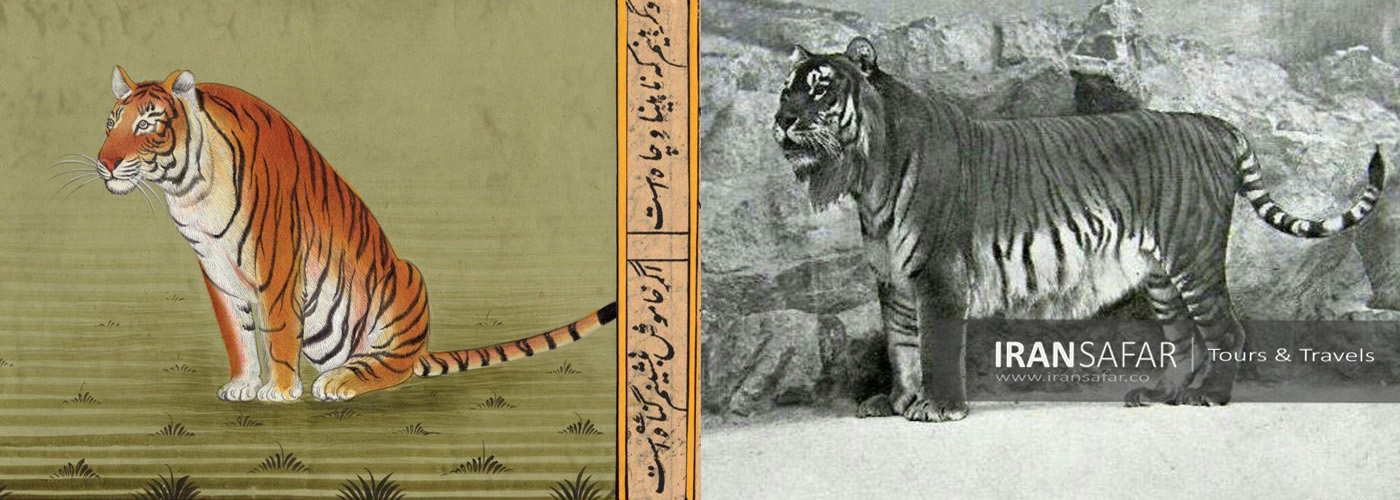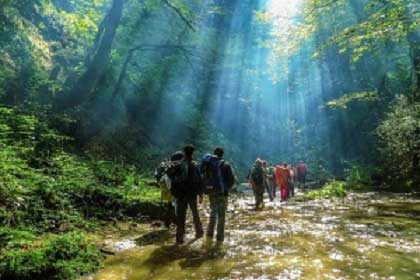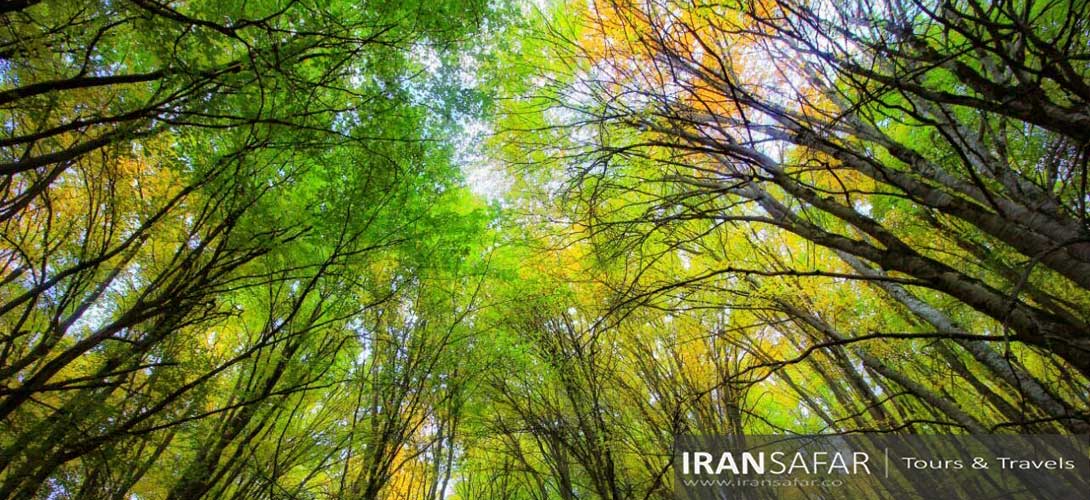It’s true that we’ve only seen dinosaurs in movies, but with just a few hour drive from Tehran, one can be in forests that are just as old as dinosaurs. Located in the south of the Caspian Sea, from Mazandaran to Gilan, from Gorgan to Arasbaran, there are Hyrcanian forests, forests that are of great value and have been registered by UNESCO.
Hyrcanian forests of Iran so-called “Northern Forests” form the most dense forest area of this country. Located in the south of the Caspian Sea, these forests are shared between Iran and Azerbaijan. Hyrcanian forests have been there from 40 million years ago.
Where are the Hyrcanian Forests?
From the Hyrcania ancient region in the Republic of Azerbaijan to Astara (the Iranian border city) there are spectacular old forests that enjoy temperate climate of the region. This eco-region continues along the south coast line of the Caspian Sea and the northern slopes of the Alborz Mountain range. It covers parts of five provinces of Iran from east to west including: North Khorasan Province, Golestan Province (entirely southern and southwestern areas as well as parts of the eastern regions of the Gorgan plain, Mazandaran Province, Gilan Province and Ardabil Province.
The area of these 40 million year old forests is 55,100 square km with 2 million hectares in Iran and 20,000 hectares in Azerbaijan. Its height starts from the sea level and reaches 2800 meters above the sea level. Unfortunately, almost half of these forests are now deforested, and only 10.3% of them is heavily protected.
Hyrcanian forest ecosystems are home to 296 bird species and 98 mammal species. There are also 150 native plants including trees and shrub plants such as buxes and beech trees.

Cloud forest, an example of Hyrcanian forests
One of Iran’s most spectacular landscapes is in the cloud forests. Because of their location in the mountains where the mountains let the clouds get through and come into the forest through them due to the air pressure difference. This phenomenon makes you able to walk on the clouds. Shahroud Cloud Forest is one of the most beautiful and spectacular areas of Iran, located 45 kilometers north of Shahroud in Semnan province. In fact, these forests are the border between the semi-arid areas of Semnan province and the Hyrcanian rainforests in Golestan province, where the sky and the earth are intertwined as one can see an ocean of clouds. The Cloud Forest, with an area of 35,000 hectares, is a vast area that has created a unique and atmospheric environment due to specific climatic conditions. The existence of certain plant species dating back thousands of years, low temperatures, high forest elevation and special vegetation have made this area different from other forested eco-regions of Iran. Read more about Iran’s Natural Attractions
Causes of Hyrcanian Deforestation
Although Iran is a poor country in terms of vegetation, we still witness a huge decline in the Hyrcanian eco-region each year.
One of the main causes of this destruction is the unrestrained expansion of the wood and paper industries and the changing use of these forests. Another major destructive factor is construction projects, such as the construction of dams without sufficient research. Golwerd Dam in Mazandaran province is an example, where more than thirty thousand trees were cut in the project. Other factors include uncontrolled grazing domestic livestock and illegal constructions. Also in the not too distant past, millions of cubic meters of wood were used in Coal industries, which fortunately has been neglected today.
Hyrcanian Forests Flora
These forests mostly consist of broad-leafed species that are adapted to the humid, semi-Mediterranean climate. Hyrcanian forests often have different vegetation depending on the altitude (sea level, low altitudes mountain foot, high mountains, and very high places). The most famous of these trees are Beech, Oak, Alder, Elm, European Ash, Box-tree, etc. Categorized as Deciduous broad-leafed Trees, in total, there exist 150 species of trees and shrubs in the Caspian eco-region. The tree types in the lowland area also differ from the trees in the high slopes and areas.
Categorized as Deciduous broad-leafed Trees, in total, there exist 150 species of trees and shrubs in the Caspian eco-region. The tree types in the lowland area also differ from the trees in the high slopes and areas.
Beech, Oak, Maple, Elm, Alder, European Ash, European Hornbeam, Yew, Lindens, Parrotia persica, Caucasian wingnut, Lilac, Date-plum, Fig and Box-trees are more abundant than others.
Hyrcanian Forests Fauna
Although the Hyrcanian forests were once famous for their Caspian Tigers, they still have beautiful and attractive species that have made these forests special for UNESCO and nature lovers of the world. It is true to say that one of the reasons that caused the UNESCO evaluators to consider Iran’s Hyrcanian forests superior to the rival Colchic Rainforests in Georgia was its biodiversity and wildlife.
Iran’s Hyrcanian forests are home to a significant variety of animals over the years. Currently, there are 296 species of birds and 98 species of mammals. Also, 150 native trees and shrubs can be found in this region. In addition to more than 3,000 different plant species and hundreds of animals, the Hyrcanian forests are the main habitat of the world-famous Iranian Cheetah. It is also home of more than eight million people, which plays a significant role in economic and social security.
Meral, brown bear, leopard, boar, Jungle cat, wolf, wild goat, common fox, jackal, and many species of birds such as Common wood pigeon, jay, Shrike, Common buzzard and Lesser Spotted Eagle are some of the unique species whose habitats are Hyrcanian forests.

Hyrcanian Forest UNESCO World Heritage List
The age of these forests and the inadequacy and the type of its plants prompted applies and requests for UNESCO World Heritage Registration. At first the Republic of Azerbaijan made this request, but since most of the forests were located in Iran, Iran proposed a joint request with Azerbaijan, and the request was submitted to UNESCO and registered.
Golestan National Park
Golestan National Park is the oldest registered national park in Iran and one of the oldest ones in the world. This park with an area of more than 90,000 hectares, is located on the common border of the provinces Khorasan, Semnan and Golestan.
Golestan National Park is one of the most important wildlife habitats in the country. It was declared as a conservation area in 1957, and following multiple changes of name, it was eventually registered as one of the fifty natural biosphere reserves of the world by UNESCO in 1975 and was registered as a natural heritage of Iran in 2008. The ecosystem of this park includes 1350 species of plants and 302 species of animals, which is extraordinary in its kind. One-eighth of the plant species, one-third of the bird species and more than fifty percent of the country’s mammal species live in the park.
 The Caucasian Leopard or Persian Leopard, is one of the biggest of the eight recognized sub species of leopard.
The Caucasian Leopard or Persian Leopard, is one of the biggest of the eight recognized sub species of leopard.



Comment (0)